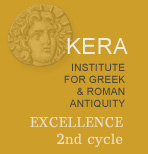Main Site . Sebasteion
22. Inscriptions on bronze sculptures (Sebasteion?)
![]()
a. Ạ
Bronze head of a bearded young man in the J. Paul Getty Museum, inv. 71.AB.458. An alpha with broken cross-bar was incised in the wax working m odel on the interior of the neck.
Height: 0.16 cm.
Mattusch 1996, no. 44, pp. 311-312 (p. 311, 44e: photograph); SEG 46 (1996), no. 1705; Queyrel 2003, p. 117, no 4.
According to İnan 1979, pp. 267; 283-284; 285-287 and 1993, p. 233, this head is unlikely to belong to the Sebasteion group, but might have come from another building in Boubon (İnan 1979, p. 287). Mattusch 1996, p. 311 " A close look reveals exactly how the letter was cut in the wax: first the right side, then the left side, and finally the broken bar, from left to right. It is quite possible that this alpha was a guide or match mark needed in a large workshop: maybe it ensured that this head would be attached to the correct type of body, or to a body that was similarly marked; or maybe it identified the head as belonging to a particular commission. Curiously enough, the colossal torso [identified as Commodus; cf. nos 13 and 22b] had the same kind of alpha punched into the bronze surface after casting ".
b. ΑΤΤΑ
Inscription on the bronze torso representing Commodus according to İnan 1993, pp. 222-225 (see no. 13). A chisel-like tool was used to punch the letters on the right side at the back of the torso just above the hip, after the bronze was cast.
Mattusch 1996, no. 55, pp. 349-351 (p. 350, 55e: photograph); SEG 46 (1996), no. 1705; BullÉp. 1997, no. 85; Queyrel 2003, p. 118, no 5.
This piece is part of a private collection in the United States (İnan: "Dr. Sackle collection"). The four letters have been interpreted as a reference to Pamphylian Attaleia (Vermeule 1980, p. 187, who saw in this torso a representation of Zeus), but cf. M. Sève, BullÉp. 1997, no. 85; SEG 46 (1996), no. 1705; Mattusch 1996, pp. 349-351. Αccording to Queyrel 2003, pp. 117-118, no. 5, a head of the Pergamene king Attalos I (241-197 BCE) may belong to this torso, in which case ATTA should be interpreted as part of his name. Finally, according to Donderer 2004, pp. 84-85, the letters represent an artist's signature. Donderer, however, wrongly assumes that the letters were inscribed on a supporting element as opposed to the statue itself. Mattusch 1996, p. 3 51: " There is no explanation of why the insription was punched into the outside of this bronze statue, nor of why the inscription is in such a prominent position."

